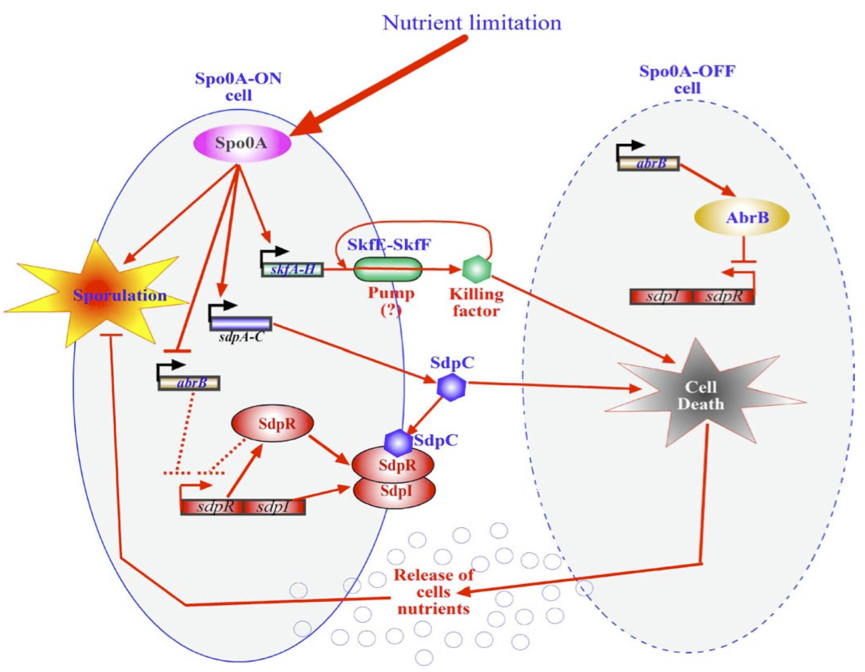Team:Groningen/Killswitch model
From 2010.igem.org
Kill Switch
For safety reasons a kill switch is needed in our project. When our hydrofobic biofilm would be applied as a coating, the cells should be programmed to die after the expression of the chaplins. In safety regulations only the release of living genetically modified organisms is a problem. So with a kill switch, the applications for our biofilm will be broader and easier to realize. Different types of kill switches are found in nature. Some of these switches are briefly discussed below.
Toxin/antidote system
One of the mechanisms is the plasmid addiction system of bacteriophage P1 that consists of a toxin (Doc) and an antidote (Phd). Cells that have lost the P1 genome will die because the antidote is gradually degraded. Gazit et. al. suggests two different functions of the antidote. First, it is possible that it binds the toxin and physically blocks the interaction of the toxin with the target molecules or by altering the structure of the toxin and thereby the toxin activity. The second option is that is activates another protein that neutralizes the toxin. In E. coli different addiction systems are found for different low copy plasmids. All those systems are based on a stable toxin and a proteolytically unstable antidote.
Killswitch coupled to sporulation in Bacillus subtilis
Within Bacillus subtilis a system is found whereby the sporulation process is delayed by killing surrounding cells. Cells that are Spo0A-Off are lysed whereby nutrients are released. These nutrients can be consumed by the Spo0A-On cells thereby delaying the process of sporulation The skf and sdp operons are responsible for the death of a subpopulation of sporulating bacterial cells. The regulatory protein Spo0A upregulates the sporulating killing factor (skfA-H operon) and the sporulating delay protein (sdpABC operon). Surrounding cells that are Spo0A-Off are killed by the extracellular killing factor skf, produced by Spo0A-On cells. An SkfE and SkfF together act probably as an export pump that secretes the killing factor and thereby protects the cell. Another killing factor is sdpC. The Spo0A-On cells have two mechanisms that provide resistance to sdpC. The first one is the SdpC-SdpI-SdpR signalling pathway. The second is the repression of AbrB synthesis. A schematic overview of this mechanism is given below.
Anti-sense RNA regulation
In Gram-positive bacteria antisense RNA-regulated stability is found.
Promoters for RNA I and RNA II are indicated by black arrows on each end. The open reading frame, fst, encodes for a 33-amino-acid peptide. The two RNAs read in opposite directions across direct repeats labelled DRa and DRb (arrows) to a bidirectional terminator (converging arrows) (Greenfield, 2000).
The so-called par region encodes for two small RNAs , RNAI and RNAII as depicted in the above figure. RNAI is 210nt long and contains the fst gene which encodes the toxic compound. RNAII is only 65nt long and highly complementary to RNAI. This results in complex formation whereby RNAI is not able to translate the fst gene into the faecalis plasmid-stabilizing toxin compound. The half-life time of RNAI is only 10 minutes while the half-life time of RNAII is more than one hour. (Zielenkiewicz)(Greenfield) This difference can be used as some sort of timer on a killswitch. Our model is based on this kill switch system.
Promoters
Two promoters can be used to connect the killswitch to the biofilm formation pathway. The first option is the srfA promoter, which is activated, already in the early stages of biofilm formation. The second option is the yqxM promoter, which is only activated from the beginning of the stationary phase. In theory, both promoters can be used to activate the par region and initiate the kill switch.
The same promoters can also be used to express the chaplins at a certain stage in the biofilm formation. It might be possible that early expression of chaplins will cause problems in biofilm formation. If this is the case, the yqxM promoter would be a nice alternative for the srfA promoter because of the late activation of this promoter.
The activation of the par region can be modeled with a simple activator term. The degradation of the two RNAs can be modelled with half life equations. The change in biomass can be modeled with a simple growth model combined with the delta tox.
References
Zielenkiewicz and Ceglowski, Mechanisms of plasmid stable maintenance with special focus on plasmid addiction ystems, ABP vol. 48 No.4/2001 1003-1023
Greenfield et al., The antisense RNA of the par locus of pAD1 regulates the expression of a 33-amino-acid toxic peptide by an unusual mechanism Molecular Microbiology (2000) 37(3), 652±660.
Gazit and Sauer, The Doc Toxin and Phd antidote proteins of the bacteriophage P1 plasmid addiction system form a heterotrimeric complex.
Kulka et al, Bacterial programmed cell death and multicellular behavior in bacteria, Plos genetics 2(10) e135 DOI: 10.1371/journal.pgen.0020135
 "
"

